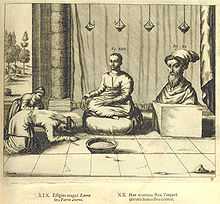Thomas Manning (sinologist)

Thomas Manning (November 8, 1772 – 1840) is considered the first lay Chinese studies scholar in Europe and was the first Englishman to enter Lhasa, the holy city of Tibet.
Life


Manning was born in Broome, Norfolk. After leaving school, Manning entered Gonville and Caius College, Cambridge to study mathematics, but "from scruples affecting the tests" did not graduate.[1] Long devoted to Chinese studies, he studied medicine and Chinese at Paris from 1800 to 1803. His desire to penetrate to the heart of the Celestial Empire took him to Canton in 1807 and on to Calcutta in 1810. Manning proceeded with a single Chinese servant and without official government sanction to Rangpur. By the 29th of October, 1811 he reached Parijong on the Tibetan border, where he was met by a Chinese general with troops. When Manning succeeded in curing some of the troops of illness, he was allowed to travel in their company as a medical man. By this route, he finally reached Lhasa, where he remained for several months. Not only did Manning thus become the first Englishmen to visit Lhasa, but also the first to obtain interviews with the Dalai Lama. After five month he was compelled to return to India. In 1817, as a member of a British delegation, Manning reached China for the first time. But the delegation was not accepted by the Chinese emperor Jianqing and were forced to leave Peking, some days later. Traveling back to England, he met Napoleon on the island of Saint Helena, where the emperor spent the last six years of his life under British supervision. Manning died in 1840 at his home near Dartford (England).
Manning's Work
Manning never published anything regarding his journey, and its occurrence was known to few, until his narrative was printed, through the zeal of Sir Clements Markham, secretary of the Royal Geographic Society, in 1876.
In his journal he described his meeting with the 5-year-old 9th Dalai Lama: "the nice and fascinating figure caught my whole attention and it was a pleasure to talk to this well educated little prince." He also described the occupation of Tibet by the Chinese: "I was struck with the appearance of everything being perfecly Chinese." If Manning was impressed by the Potala palace, his admiration stopped there. "If the palace had exceeded my expectations," he wrote, "the town as far fell short of them. There is nothing striking, nothing pleasing in its appearance. The habitations are begrimed with smut and dirt. The avenues are full of dogs, some growling and gnawing bits of hide which lie around in profusion, and emit a charnel-house smell; other limping and looking livid; others ulcerated; others starved and dying, and pecked at by the ravens; some dead and preyed upon. In short everything seems mean and gloomy, and excites the idea of something unreal."[2]
Manning was the "friend M." of Charles Lamb, from whom "Elia" professes to have got that translation of a Chinese MS. which furnished the Dissertation upon roast pig. A number of letters from Manning to Charles Lamb have survived and are contained in a book edited by G.A. Anderson published by Harper & Brother, New York, 1926.
References
- ↑ "Manning, Thomas (MNN790T)". A Cambridge Alumni Database. University of Cambridge.
- ↑ Peter Bishop, The Myth of Shangri-La: Tibet, travel writing, and the western creation of sacred landscape, University of California Press, 1989, 308 p., p. 94.
Further reading
- MARKHAM, Clements R., Narratives of the Mission of Georges Bogle to Tibet and of the Journey of Thomas Manning to Lhasa, New Delhi: Cosmo Publications, 1910 [1876] (Indian Historical Researches, 42).
External links
- Ergriffen vom Dalai Lama (German newspaper article about the journey of Thomas Manning to Lhasa)
- Archival material relating to Thomas Manning (sinologist) listed at the UK National Archives